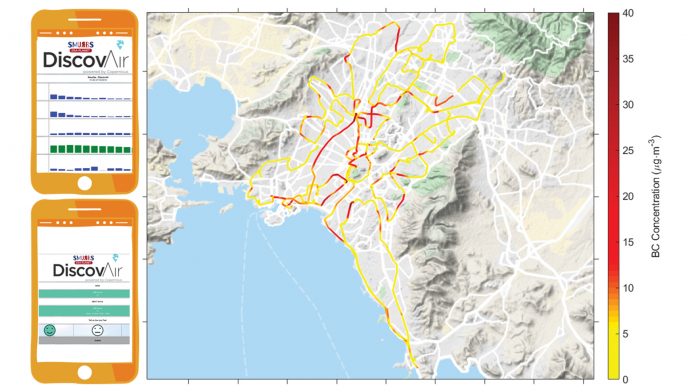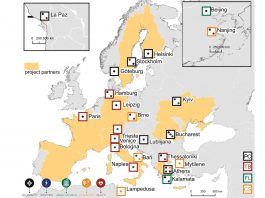Dr Evangelos Gerasopoulos, coordinator of the SMURBS/ERA-PLANET project, advocates for earth observation as an integral part of a smart city and outlines the progress made on the project’s portfolio of solutions for urban environmental stressors.
Owing to the continuing trend of urbanisation, cities constitute hot spots of environmental stressors as a result of a large number of people living there whilst also undergoing activities. Moreover, they are at risk of exposure to air pollution, disasters, as well as other pressures connected to urban growth. The SMURBS project continues to address these themes through exploiting novel earth observation (EO) approaches synthesised into a portfolio of smart city solutions, tailored to user needs ensuring applicability and efficiency in building a city’s resilience.
The project at a glance
The SMart URBan Solutions for air quality, disasters and city growth (SMURBS) project, one of four ERA-PLANET projects funded by the EU Horizon 2020 Research & Innovation Program, focuses on air quality (AQ), disaster management, urban growth (including migration aspects) and the health implications of urban pressures. Converging under the smart city banner, the SMURBS consortium includes 19 partners from 12 European countries amassing a wide array of expertise to develop synergies between EO platforms (i.e. satellites, in-situ monitoring, modelling, smart sensors and citizen observatories) to alleviate these pressures. The amalgamation of these efforts is the creation, testing, and delivery of a portfolio of smart urban solutions to address city stressors, which are developed, refined and showcased in pilots within the SMURBS city network.
Portfolio of smart urban solutions
In the two years since the project’s commencement, partners have worked diligently to build a portfolio of smart city solutions in support of urban planners, citizens and other stakeholders. The portfolio currently contains 32 solutions (16 focusing on AQ, eight on urban growth, and eight on disasters) that are being implemented in a network of more than 25 cities. More than half of the solutions are already implemented or maintain a high level of maturity and bringing the remainder of the solutions to fruition will be a primary focus of the last year of the project. Some highlights that exemplify the diverse nature and applicability of solutions are discussed below.
Monitoring air quality for the modern citizen
An integrated network of AQ monitoring, comprised of low and mid-cost sensors as well as state-of-the-art in-situ supersites, produces near real-time AQ measurements on a variety of pollutants and new parameters (gases, particulate matter, black carbon, and particle properties). The wide deployment of monitoring devices addresses the urban complexity that drives poor AQ, captures pollution hot spots, delineates the causes behind such problem areas, and achieves a comprehensive view of air quality in a city.
SMURBS will boost citizen awareness through utilising geo-tags located in close proximity to the sensors location that link with the DiscovAIR mobile application (also available on a web platform). The app includes forecasts of AQ provided by the Copernicus Atmospheric Modeling Service (CAMS) to aid citizen and tourist planning and to avoid exposure where possible. Conversely, the user can provide their own perception and an evaluation on how they are feeling to help them explore any links between current AQ conditions and their health.
The solution significantly enhances the regulatory framework of a city, giving tailored information for decision-making to mitigate pollution levels through source apportionment, and thus reduce the exposure of city-dwellers to dangerous air pollutants.
Zooming into the city: intra-urban AQ forecasting
The SMURBS intra-urban AQ modelling and forecast solution sharpens the picture of pollution down to the ‘street’ level, providing decision-makers and local stakeholders with finely detailed spatial maps of AQ to elucidate exposure differences within a city and support further urban planning.
The solution is currently approaching operational capacity as a pilot in Hamburg (systematically producing AQ forecasts) and is being implemented in Athens as a case-study, utilising emission inventories, as well as high resolution proxies from Copernicus and the Joint Research Centre (JRC), a state-of-the-art city-scale dispersion and chemistry transport model, and CAMS regional forecast and reanalysis. The tool provides a one-day forecast of air pollutant concentrations in addition to an air quality index on web-based spatial maps.
SMURBS solutions to address city health
Many of the solutions in the SMURBS portfolio are cross-cutting in nature, resulting in health co-benefits, but within the air quality theme there are certain SMURBS solutions that utilise EO in direct support of improving citizen’s health in cities. One such solution is the use of the World Health Organization’s AirQ+ risk assessment tool, where air pollutant concentration and basic population information is used along with risk estimates from cohort studies to calculate the health effects of long- and short-term exposure to air pollution. SMURBS intends to exploit the tool to provide the health information at higher resolution within the administrative borders in many cities, such as Ljubljana, Brno and Helsinki.
Flood monitoring service: using EO and citizen science to assess risk
To address the pressure that natural disasters pose to cities, in both cost of infrastructure damage and environmental and health impacts, SMURBS partners are building on the BEYOND’s Center of Excellence Floodhub application by incorporating crowdsourced flood data. Floodhub+ is a web-based GIS platform, which monitors flood events in urban and peri-urban areas and provides further analysis on the flood extent to inform an early warning system and produce a flood risk assessment.
While Floodhub+ directly responds to an established EU policy (EU Floods Directive), it provides local decision-makers and emergency services stakeholders with an EO-backed mapping platform and risk analysis to aid in early warning and flood risk management planning. To date, the service is tested and evaluated in specific case studies (Mandra and Kifisos river basins in Athens, Greece). The fully automated and established methodology has transferability and scalability built-in to fortify cities that face flooding risks.
SMURBS support of the UN 2030 Agenda
SMURBS is contributing to the Group on Earth Observation (GEO) global community in advancing the use of EO in aid of achieving the UN 2030 Agenda for the Sustainable Development Goals (SDG) and the EU Urban Agenda. While it is acknowledged that EO is necessary to achieve the ambitiousness laid out in the SDG targets, actual implementation of EO for monitoring the SDG indicator framework (i.e. the means of monitoring progress of the targets and goals) is still in its infancy.
SMURBS is providing EO-based, operational and freely available tools tracking city monitoring and progress towards the urban target (SDG 11), in the case of at least three of its indicators: the proportion of urban population living in slums, informal settlements or inadequate housing (11.1.1), the ratio of land consumption rate to population growth rate (11.3.1), and the population-weighted annual average concentration of fine particulate matter in cities (11.6.2).
The latter is realised in a tool to monitor the indicator at the city level utilising free, state-of-the-art EO data provided by the Copernicus Services and the Global Human Settlement Layer. The tool illustrates the sensitivity of the indicator to the definition of a city’s extent and offers an elegant portal for city stakeholders to better perceive the policy implications and assists in actually meeting the SDG Target.
The way forward
In the throes of implementation, the SMURBS project continues to create and execute smart city solutions, focusing on seamless replication in follower cities. Engagement with relevant stakeholders also ensures sustainability of the initiatives being pioneered through continued exploitation of the portfolio.
The SMURBS community is working to produce policy papers on a range of solutions within the portfolio to further disseminate smart city tools to build city resilience, as well as stimulate discussions on what a smart city looks like and how EO can arguably help it get there.
SMURBS and their community of partners, cities, and stakeholders continue their work to help cities become resilient in the face of environmental stressors and work to institute programs and policies that protect citizens’ health and address air quality, natural disasters and urban growth.
Dr Evangelos Gerasopoulos
Research Director
National Observatory of Athens (NOA)
+30 210 8109124
egera@noa.gr
smurbs.project@gmail.com




